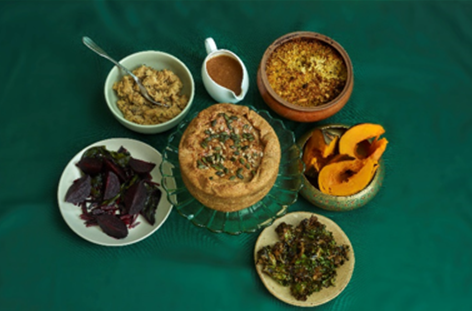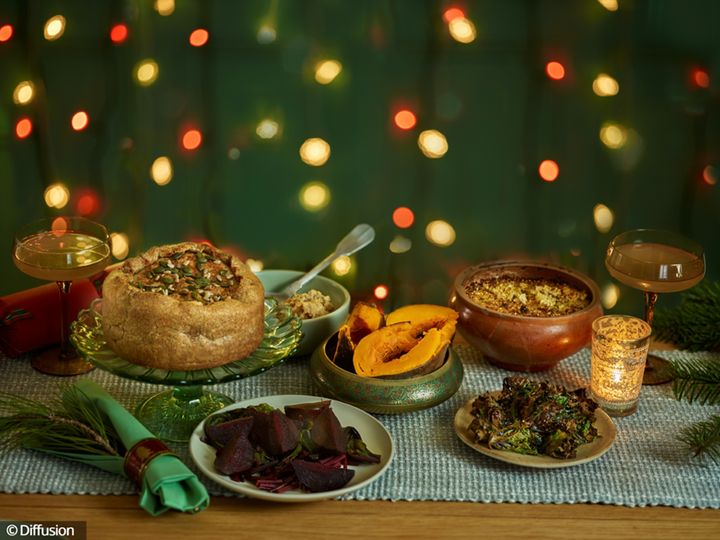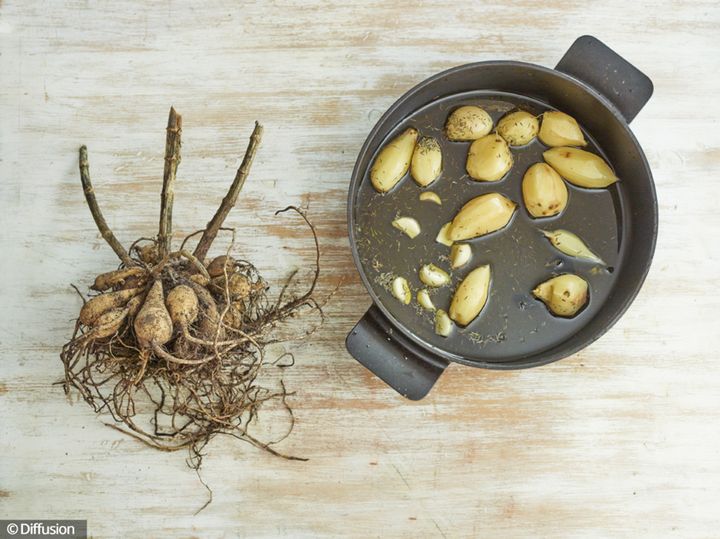
With Christmas almost upon us, many of us are looking forward to tucking into our traditional turkeys, roast potatoes and stuffing.
However, climate change could dramatically alter the look of our beloved Christmas dinner by the end of the decade – with many of our much-loved foods under threat. That’s according to Seeds of Change, a new report by communications consultancy Diffusion, which has partnered with chef Kimberly Duke to create a “climate-change proof” Christmas Dinner for a picture of what we might be eating at Christmas in a few years’ time.
Unusual new ingredients like dahlia tubers and amaranth seed stuffing could be the new staples of our festive dining tables, according to Diffusion’s report.
More frequent droughts, heatwaves and unseasonably warm autumns and springs threaten the quantity and quality of many winter vegetables and grain crops traditionally grown in the UK.
This could lead to shortages and potentially having to pay more for our festive favourites in the future. The production of meat is also not immune from these trends, turkey and pork prices have increased by nearly 30% this year.
Long-term prices are likely to be higher, as demand for the wheat, soy and sunflower oil that goes into animal feed soars, because of a growing global population.
And the report finds that UK shoppers are already changing their shopping habits, with 62% of consumers planning on buying plant-based meat, fish and dairy alternatives more often in 2023.

Professional chef, food writer, and plant-based menu specialist Kimberly Duke developed her Climate Change Christmas Dinner, informed by the report’s findings.
Some of the “new” ingredients on her menu are actually ancient grains, resistant to a harsher climate, which the report finds could become more common on our plates in the future, alongside sustainable alternatives to turkey. These options are better for both the environment and our bank balance, it says.
The centrepiece of Duke’s alternative menu is a pie that replaces the traditional turkey roast, with pulled jackfruit and miso. The recipe recreates both a rich meaty flavour with the natural texture of the jackfruit and enoki mushrooms mimicking that of meat beautifully.
Jackfruit is now readily available tinned in supermarkets, and this year is 20% cheaper per kilogram than fresh turkey. Found across India and South East Asia, jackfruit trees grow sustainably without the need for additional irrigation, fertilisers or pesticides.
With a significantly lower carbon-footprint to producing meat, it is considered a leading climate-smart crop.

One of the more unusual ingredients Duke uses is dahlia tubers. They will be familiar to many gardeners who grow them for their colourful flowers, but they can be easily harvested in the autumn once they have finished flowering.
Originally cultivated by the Aztecs in central America, the tubers have been eaten for millennia and are a great alternative to potatoes, which may become more difficult to grow in the UK as the climate becomes both hotter and drier.
For her dish, Duke peeled the tubers and confited them in olive oil with dried thyme and garlic, as an alternative to roasties, but dahlia tubers can also be boiled and mashed. The flavour and texture is similar to chestnuts and Jerusalem artichokes. Dahlia tubers are also high in inulin, a low calorie carbohydrate that can boost friendly gut bacteria.
Other potato alternatives that we may begin to use more in the UK include cassava, grown across much of Africa and prized for its drought resistance.

For her stuffing, Duke used Amaranth, an ancient grain grown by the early civilisations of central and South America, replacing traditional wheat breadcrumbs.
Amaranth is high in fibre, with a higher protein content than wheat and with the added benefit of being naturally gluten free. She also climate-proofed another Christmas favourite, bread sauce, with a recipe using a sourdough loaf made using the alternative of spelt flour, as well as oat milk.
The Seeds of Change report suggests the British public are open to the possibilities of ancient grains, with 86% of UK adults willing to buy bread, baked goods and other foods that use more alternative grains, and taste and comparable pricing being the key drivers to encourage switching.
“We are in a situation today where humanity globally is dependent on just three grains – corn, wheat and rice – for half the calories we eat,” Daljit Bhurji, CEO of Diffusion says.
“This lack of variety leaves us vulnerable as our climate changes. The good news from our report is that there are plenty of climate-smart varieties out there, from ancient grains like amaranth to even possibly the dahlia tubers in our gardens as a future alternative to potatoes.”
Dr Chris Bryant – an alternative proteins expert who contributed to the Seeds of Change report said: “Christmas is a time when we really think about food, and I think that’s something we have a responsibility to do more of all year round.”
He adds: “Supermarkets, food producers and governments also have a critical role to play in highlighting the benefits that reducing our demand for animal protein can play in protecting not only our food security, but our public health and the climate as well.”